Before Ernst Lubitsch and Cecil B. DeMille poked their heads into the bedroom, Ladislas Starevich directed this clever marital comedy about a wayward husband, a temperamental wife, a lovely dancer and a jilted cameraman. Of course, what really sets Starevich apart is his cast. You see… the parts are all played by dead insects.
A dead cast is the best cast.
While Disney is worshiped as an animation pioneer and Lotte Reiniger is finally getting some of the attention she deserves, Ladislas Starevich is a footnote at best. He was not the first stop-motion animator but he was one of the most creative. His approach to his animation—cartoons that weren’t just for the kiddies—is quite modern and makes his work extremely accessible compared to other movies of the early ‘teens.
Born in 1882, Starevich’s two talents were graphic design and entomology. These skills collided and soon Starevich was making films starring insects, puppets and even the odd human being. He found success but ike so many others in the pre-Revolution Russian film industry, Starevich fled the victorious Bolsheviks and ended up in France where he continued his wildly creative career.
The Cameraman’s Revenge is one of Starevich’s earliest surviving films (certainly the earliest available on home media at present) and it is also his most famous. Let’s take a close look at the film and see why it’s so beloved over a century after its release.
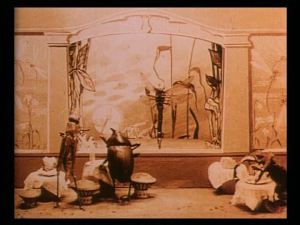
We are introduced to a world occupied entirely by insects. The middle class couple Mr. and Mrs. Beetle have grown bored with their marriage and have sought companionship from outsiders. Mr. Beetle treks to the city where he meets his lover at a nightclub. She is a dragonfly, a popular dancer with a very annoyed ex-boyfriend. The ex is a grasshopper but he is also the titular cameraman and he means to get himself some of that revenge.
The grasshopper follows Mr. Beetle and the dragonfly to the hotel where they are staying. He films every step of their tryst, even placing his camera lens against the keyhole of their hotel room door at one point. Mr. Beetle catches him in the act but the grasshopper gets away with his camera and film.
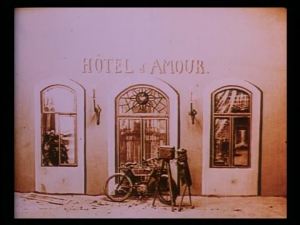
Meanwhile, Mrs. Beetle has taken up with an artist. When Mr. Beetle returns home and catches his wife with her antenna wound around another insect, he throws the artist out. He then magnanimously forgives his wife and even offers to give her a treat. There is a new movie in town, wouldn’t that be a perfect date night for the reconciled couple?
Three guesses as to who operates the projection booth…
As you probably noticed, The Cameraman’s Revenge hits on several rather mature themes. We get adultery, the sexual double standard, voyeurism…

What is most intriguing is that Starevich makes no concession to cuteness. The insect cast inhabits a miniature world but other than the names of the married couple and a brief scene of a tiny car driing down a garden path, there is not a bit of cutesiness about the film. In fact, with just a few name changes, the script could have been filmed by a human cast and not missed a beat.
On the subject of sophistication, one of the best things about The Camerman’s Revenge is its use of title cards. The intertitles are droll and understated.
His business always took him to the Gay Dragonfly Nightclub. The dancer there understood him.
and
Mrs. Beetle is also restless. Her friend is an artist.
In both these cases, the cards could have come from any relationship drama of the period played by humans. This refusal to descend into the cutesy is part of the secret of this film’s appeal. Our entire cast may be insects but their behavior is all too human.
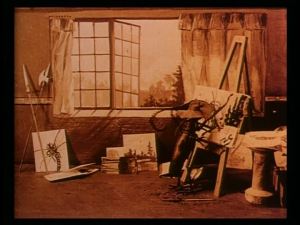
While the story and cards are very good, this is still an animated film and its success depends on how well the characters are manipulated. Starevich used stop motion to bring his characters to life. It’s the same technique used for Gumby and the acclaimed Aardman productions. The puppets, props and other visual elements are carefully moved a millimeter, a fraction of a second of footage is shot and then the work is repeated. It’s time consuming and arduous but it also creates an organic and tactile world that even the best computer animation cannot match.

While a lot of early animation was used making trick films and generally showing off the new technology, Starvevich’s technique is used in the service of his story and never feels like a gimmick. Further, his eye for detail creates a believable world populated by bourgeois insects.
How detailed was Starevich? Well, take a close look at the scenes. When the grasshopper sets up his camera, it would have been easy to have him plunk it down and start shooting. Instead, he spreads out each tripod leg individually and makes sure that the camera is steady before he goes to work. (Starevich served as cameraman in some live action productions around this period. Could it be that the film has an autobiographical aspect?)

There are other small delights. Mrs. Beetle’s artist lover is shown painting her portrait on canvas with a tiny brush. He also wears the sort of extravagant hat popular among the artistic classes. A huge feather fluttering as he walked.
Keep in mind, this was 1912. I’m pretty impressed.
(Note: Starevich’s name is spelled all kinds of ways. Vladislav Starewich, Ladislaw Starevitch, Władysław Starewicz, etc. I have opted to use the easiest-to-pronounce spelling. Whatever spelling you may prefer, just know that a Władysław by any other name will smell just as sweet.)
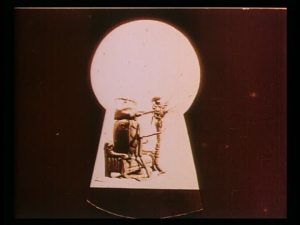
The Cameraman’s Revenge represents an important step forward in the world of animation. Starevich’s taste, sophistication and imagination were years, perhaps decades ahead of their time and this film displays these strengths very well. This is a must-see.
Movies Silently’s Score:★★★★
Where can I see it?
The Cameraman’s Revenge was released on DVD as part of the Wild and Weird collection. Also available on the out-of-print The Cameraman’s Revenge and Other Fantastic Tales disc.
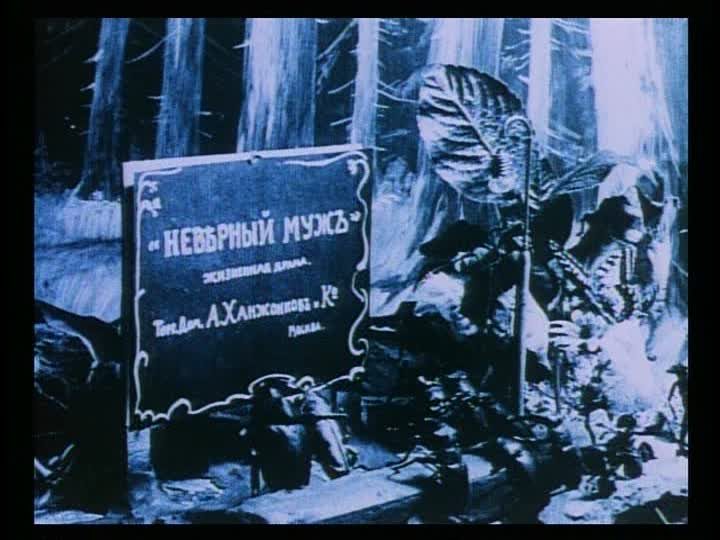
Lots of the early animation pioneers are ignored. Quirino Cristiani made the first animated feature film “El Apostol” in 1917, but people still regard Snow White or Prince Achmed as being the first. Have you ever read “Before Mickey”? It covers silent animation pretty well.
That being said, this looks fascinating, but I don’t know if I could watch it, as insects squick me out.
Ha! Yeah, plus these are dead insects so that makes things a bit grosser, I would imagine. No, haven’t read Before Mickey but will have to check it out.
Yeah, the dead insect part makes it a bit like post-mortem photography in the 19th century. So creepy!
When I saw the title, I thought for a second “I didn’t know Buster made a sequel!”. Just a second, mind you. I need more coffee…
😉 Happens to all of us.
OMG I wish I lived in the alternate universe where that sequel existed.
Nice! You beat me to it – I’m planning to spotlight some Starevich films in just a couple of weeks as well. Winsor McCay liked to claim he had “invented” animation with Little Nemo, but like most “firsts,” it was just ballyhoo. (I still like McCay, I just don’t trust him as a source).
Oh yes, definitely. The label of “first” is really overrated. McCay was great as McCay, whether he was first, second or last.
One can do a lot worse than an imagination-packed evening of animation by Starevitch (or is it Starewicz?), Émile Cohl, Willis O’ Brien and Charley Bowers – innovators all.
Yes, early animation is really underappreciated. And Starevich’s name is any way that works for you. I stopped counting a few variations back. 😉